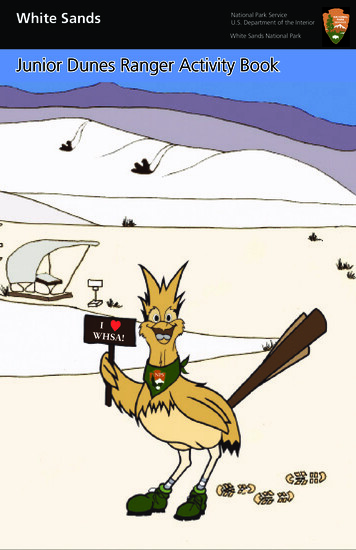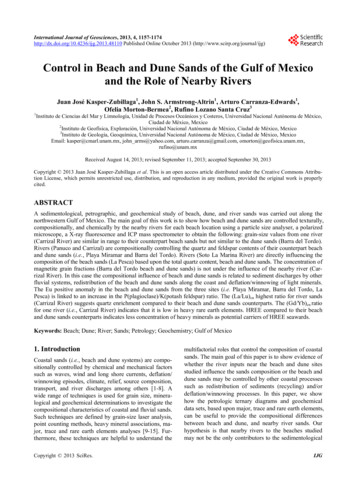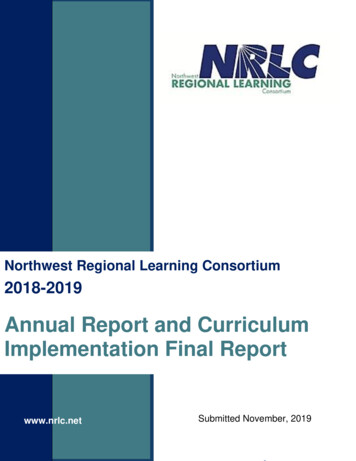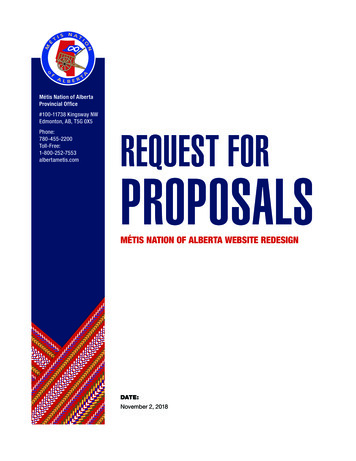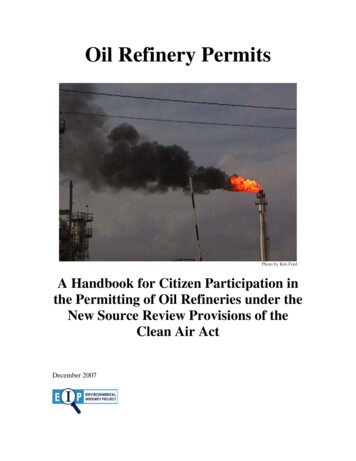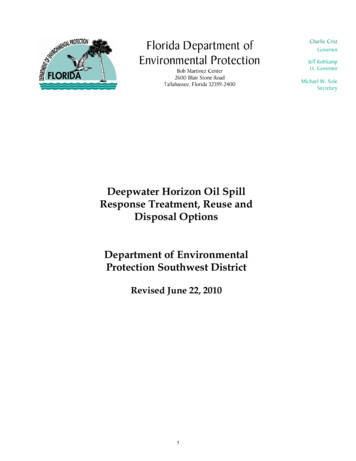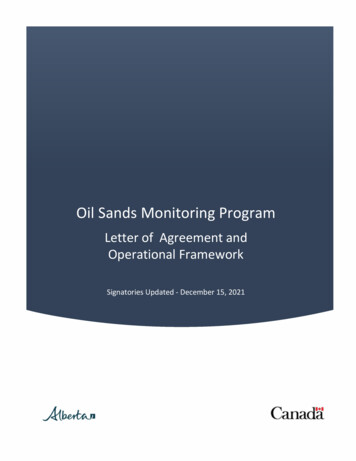
Transcription
Oil Sands Monitoring ProgramLetter of Agreement andOperational FrameworkSignatories Updated - December 15, 2021
Oil Sands Monitoring Program Letter of Agreement and Operational Framework AgreementRecommended Citation:Dubé M., Cash K., Wrona F., Enei G., Cronmiller J., Abel R., Andreeff W., Berrade D., Davidson C., Dawson J.,Dersch A., Dertien K., Donald G., Evans M., Fayant K., Gladue B., Gosselin J., Ilesanmi Y., Ladouceur B.,Lawrence L., Lee-Johnson E., MacDermid F., MacLean B., New B., Schaldemose L., Scoville D., Starr C.,Tomlinson G., Wells C. and M. Zhira. 2018. Oil Sands Monitoring Program Letter of Agreement andOperational Framework Agreement. Oil Sands Monitoring Program. 53 pp. ISBN: 978-1-4601-4236-3.ISBN: 978-1-4601-4236-3 (PDF)Posted November, 201
Page 1September 21, 2018Oil Sands Monitoring ProgramLeƩ er of AgreementIn December of 2017, the Government of Alberta and the Government of Canada signed aMemorandum of Understanding (MOU) that renewed each Government’s commitment to monitoring ofenvironmental impacts of oil sands development through the Oil Sands Monitoring Program (OSMProgram). The MOU acknowledges that treaty and aboriginal rights of Indigenous people are recognizedand affirmed in sec on 35 of the ConsƟtuƟon Act, 1982.The MOU established the mutual inten ons of both governments to collaborate and be accountable forthe design and implementa on of an integrated monitoring, evalua on and repor ng system and toconfirm the joint commitment to revise and establish, in coopera on with Indigenous communi es inthe oil sands region, effec ve mechanisms for Indigenous par cipa on in the design, implementa onand governance of the monitoring system. This commitment included development of a comprehensiveagreement—the OperaƟonal Framework Agreement—that defines the governance and implementa onmodel that will be used to guide the decision-making structure and processes; roles and responsibili es;and the monitoring, research mandate, and objec ves of the OSM Program.In the spring of 2018, all Indigenous communi es in the oil sands region were invited to join a Task Teamto develop the Opera onal Framework Agreement. Representa ves of 17 of those Indigenouscommuni es, along with officials from the Government of Alberta and the Government of Canada, havesince worked to develop the Opera onal Framework Agreement, based on the MOU, which outlines thevision, principles, objec ves and desired outcomes of the OSM Program. The Opera onal FrameworkAgreement is now complete, and establishes a collec ve approach for the oversight and management ofthe OSM Program.This Le er of Agreement and the Opera onal Framework Agreement are made in accordance withSec on 2 of the Oil Sands Environmental Monitoring Program RegulaƟon. The intent of this Le er ofAgreement is for the Governments of Alberta and Canada (the Par es as established under the MOU) aswell as Indigenous communi es in the oil sands region to endorse the Opera onal FrameworkAgreement and to confirm the commitments made to govern the OSM Program in a manner consistentwith the MOU, including that the treaty and aboriginal rights of Indigenous people are recognized andaffirmed as per sec on 35 of the ConsƟtuƟon Act, 1982. In addi on, good governance will ensure thatmonitoring considers Indigenous community and stakeholder concerns or issues as priori es,appropriate scien fic and Indigenous exper se is u lized, the monitoring system incorporatesIndigenous designed and led community-based monitoring, and indicators that are relevant toIndigenous communi es are monitored.This Le er of Agreement is intended to be a collec ve commitment to uphold the values and principlesestablished in the MOU while ensuring solid, shared governance and implementa on of the OSMProgram through the Opera onal Framework Agreement. The LOA also ensures that Indigenous peoplesas partners in the OSM Program as established under the Opera onal Framework Agreement, may havecertainty around the governance and decision-making processes of the OSM Program and itsrela onship to the orders of government. This Le er of Agreement and Opera onal Framework
Page 2Agreement are viewed as important tools for effec ve governance around an integrated monitoringsystem to be er assess cumula ve environmental effects to inform land use management, policy,regula on and other such measures and ac ons in pursuit of minimizing the effects of oil sandsdevelopment.By signing this Le er of Agreement, the signatories are endorsing the Opera onal FrameworkAgreement. In addi on, the Government of Alberta and the Government of Canada reiterate theircommitment to the OSM Program as established in the MOU and its implementa on through thisOpera onal Framework Agreement. Finally, the Government of Canada reiterates its commitment tocontribute an addi onal amount of up to 2,000,000.00 for development of capacity for Indigenouscommunity-based monitoring in the oil sands region, as outlined in the MOU.This Le er of Agreement and the a ached Opera onal Framework Agreement are statements of intentand do not create any legally binding obliga ons between any of the signatories to this Le er ofAgreement.Nothing in this Le er of Agreement or the a ached Opera onal Framework Agreement alters thelegisla ve or other authori es of the Government of Alberta or the Government of Canada or the rightsof Government of Alberta or the Government of Canada with respect to the exercise of their legisla veor other authori es under the Cons tu on of Canada.The signing of this Le er of Agreement does not abrogate any responsibili es of the Government ofAlberta or the Government of Canada for consulta on, mi ga on or accommoda on associated withsec on 35 of the ConsƟtuƟon Act, 1982.Endorsement of the Opera onal Framework Agreement is not a pre-condi on to involvement in theimplementa on of the OSM Program through par cipa on in established caucuses (Indigenous Caucusand First Na on and Mé s Sub-Caucuses) and work planning submissions, in keeping with theOpera onal Framework Agreement principle of inclusiveness and collabora on. Endorsement of theOpera onal Framework Agreement is, however, necessary for par cipa on in the governance anddecision-making process of the OSM Program as defined under the Opera onal Framework Agreement.All Indigenous communi es within the Alberta oil sands region are free to sign or remove their signaturefrom this Le er of Agreement at any me a er providing 30 days no ce.The Opera onal Framework Agreement and this Le er of Agreement are “evergreen” documents thatwill be reviewed and updated periodically as necessary. The Opera onal Framework Agreement may beamended in accordance with the process set out in the Opera onal Framework Agreement.Indigenous, aboriginal peoples, communi es: Case law is s ll developing and the use of these terms forthe purposes of this Le er of Agreement and the Opera onal Framework Agreement is not intended asrecogni on that any par cular First Na on or Mé s organiza on is or represents, or is not or does notrepresent, a community holding any par cular (or any) aboriginal or treaty rights within the meaning ofsec on 35 of the ConsƟtuƟon Act, 1982.Informa on collected pursuant to this Le er of Agreement, the Opera onal Framework Agreement, orotherwise through governance of the OSM Program is subject to the Freedom of InformaƟon andProtecƟon of Privacy Act (Alberta).
Page 3Therefore, together, the Government of Alberta, the Government of Canada, along with the Indigenouscommuni es, have agreed to sign this Le er of Agreement on the dates indicated below.AƩ achment: Oil Sands Monitoring Opera onal Framework AgreementSignatories from 2018 and New Signatories to Dec 15, 2021
Page 4
Justin HermanCEOChard Metis Nation17thMay, 2021
SignatureSignaturePrinted Name:Title:Community: Lubicon Lake NationPrinted Name:Title:Community:Signed this ofSigned this ofSignatureSignaturePrinted Name:Title:Community:Printed Name:Title:Community:Signed this ofSigned this ofSignatureSignaturePrinted Name:Title:Community:Printed Name:Title:Community:Signed this ofSigned this ofSignatureSignaturePrinted Name:Title:Community:Printed Name:Title:Community:Signed this ofSigned this of
Oil Sands Monitoring ProgramOperational Framework AgreementDEVELOPED BY THE OIL SANDS MONITORING OPERATIONALFRAMEWORK AGREEMENT TASK TEAMFINALSEPTEMBER 21, 2018
Oil Sands Monitoring ProgramSeptember 21, 2018Contents1.0 Introduction . 22.0 Operational Framework Logic Model for the Oil Sands Monitoring Program . 22.1 VISION . 42.2 PRINCIPLES . 42.3 OBJECTIVES . 52.4 PROGRAMS . 62.5 OUTCOMES . 62.6 ACTIONS . 72.7 PERFORMANCE MEASURES . 83.0 Governance . 93.1 STRUCTURE . 93.1.1 Oversight Committee . 103.1.2 Science and Indigenous Knowledge Integration Committee . 123.1.3 Indigenous Community Based Monitoring Advisory Committee . 143.1.4 Technical Advisory Committee(s) . 163.1.5 Caucus (es) . 193.2 DECISION-MAKING . 213.2.1 Consensus Decision-making Due Diligence Guidelines. 213.2.2 In the Event of Non-Consensus (Technical Advisory Committees, Indigenous Community BasedMonitoring Advisory Committee and the Science and Indigenous Knowledge Integration Committee). 223.2.3 In the Event of Non-Consensus (Oversight Committee) . 223.2.3 Accountability of the OSM Program Co-Chairs . 233.2.4 Boundaries . 254.0 Operational Framework Timelines . 264.1 ANNUAL WORK PLANNING PROCESS. 264.2 FIVE-YEAR CYCLE . 264.3 Administration and Revision of the Operational Framework Agreement . 26OPERATIONAL FRAMEWORK AGREEMENT APPENDICES . 28Appendix A: OSM MOU. 28Appendix B: OSM Operational Framework Agreement Task Team Terms of Reference . 35Appendix C: Operational Framework Capacity Funding Guideline. 42Page 1 of 45
Oil Sands Monitoring ProgramSeptember 21, 20181.0 IntroductionIn December of 2017, the Government of Alberta and the Government of Canada signed a Memorandumof Understanding (MOU) that renews each Government’s commitment to monitoring environmentalimpacts of oil sands development through the Oil Sands Monitoring Program (OSM Program) (AppendixA). The MOU acknowledges that treaty and aboriginal rights of Indigenous peoples are recognize d andaffirmed in section 35 of the Constitution Act, 1982.The MOU establishes the mutual intentions of both governments to continue to collaborate and beaccountable for the design and implementation of an integrated monitoring, evaluation and reportingsystem. It also confirms the joint commitment to revise and establish, in cooperation with IndigenousCommunities in the oil sands region, effective mechanisms for Indigenous participation in the design,implementation and governance of the monitoring system. This includes development of acomprehensive, ongoing agreement (the Operational Framework Agreement) that defines the governanceand implementation model that will be used to guide the decision-making structure and processes, rolesand responsibilities, and the monitoring, research mandate, and objectives of the OSM Program. The goalof this Operational Framework Agreement is to realize a collective approach that can be applied to theoversight and management of the OSM Program in the coming year and into the future.Over the spring and summer of 2018, a joint Task Team with representatives of the Government ofAlberta and the Government of Canada, and interested Indigenous Communities of the oil sands regiondeveloped this Operational Framework Agreement, which outlines the vision, principles, objectives anddesired outcomes of OSM Program. Actions, programs and performance measures are also described tosupport and achieve the outcomes. The Terms of Reference for the Task Team including its membership isfound in Appendix B.This Operational Framework Agreement is a statement of intent and does not create any legally bindingobligations between any government, entity, group, organization or community that has endorsed thisOperational Framework Agreement.Nothing in this Operational Framework Agreement alters the legislative or other authorities of theGovernment of Alberta or the Government of Canada or the rights of Government of Alberta or theGovernment of Canada with respect to the exercise of their legislative or other authorities under theConstitution of Canada.Indigenous, aboriginal peoples, communities: Case law is still developing and the use of these terms forthe purposes of the OSM Program is not intended as recognition that any particular First Nation or Métisorganization is or represents, or is not or does not represent, a community holding any particular (or any)aboriginal or treaty rights within the meaning of section 35 of the Constitution Act, 1982.This Operational Framework Agreement is a living document to be reviewed and revised as needed inaccordance with the process set out in this Operational Framework Agreement (see Section 4.0).2.0 Operational Framework Logic Model for the Oil Sands MonitoringProgramThe Operational Framework is built on a logic model that defines the vision of oil sands monitoring, andhelps participants remember why monitoring is done the way that it is, including core principles andPage 2 of 45
Oil Sands Monitoring ProgramSeptember 21, 2018Figure 1. Operating Framework Logic Model for the Oil Sands Monitoring ProgramPage 3 of 45
Oil Sands Monitoring ProgramSeptember 21, 2018objectives to support the vision (Figure 1). It then defines how the program will achieve its vision: with theoutcomes, actions, programs and performance measures. The content of the logic model is based in theMOU to ensure the Operational Framework Agreement implements the MOU as intended.2.1 VISIONAn integrated monitoring, evaluation and reporting system inclusive of and responsive to IndigenousCommunities, that includes the acquisition and reporting of regional and sub-regional data on baselineenvironmental conditions, tracking any environmental impacts, and the assessment of cumulativeenvironmental effects from oil sands development to inform management, policy and regulatory actionand respects potential impacts to section 35 Rights.The overall vision and purpose of the OSM Program is clearly articulated in the MOU and is essential todrive the governance of the program under the Operational Framework Agreement.2.2 PRINCIPLESCore principles consistent with the intent of the MOU lay the foundation for the governance of themonitoring program (Figure 1). For effective governance, the principles are understood by its users as theessential characteristics of the OSM Program, reflect its vision and are essential for effective programimplementation. The principles for the OSM Program are:Risk-basedScientificallyCredibleHolistic andComprehensivePrioritizes monitoring effort according to the magnitude of environmental impacts, includingcumulative impacts, from oil sands development. Long-term monitoring, geographic scope,and intensity will be proportional to the assessed risk to ecosystem health and exposurepathways potentially affecting human health and well-being, based on the most reliable androbust evidence available.Collects monitoring data in a manner that is reliable and valid and follows recognized qualityassurance and quality control standards. Methodology and design allows for repeatability,careful and accurate reporting that stands up to peer review by reputable third parties andfosters public trust in the results.Explicitly considers in a risk-based context the lifecycle of environmental response (e.g., shortterm to long term change, early warning, existing and predicted change, chronic and acutechange) across indicators and inclusive of cumulative effects. Explicitly considers existing,proposed and predicted stressors (e.g., potential water release) associated with oil sandsactivities. Explicitly includes western science and Indigenous knowledge.Adaptive,Robust, andProactiveAdjusts monitoring intensity to be proportional to the assessed risk of environmentalimpacts. The goal is that more consequential impacts will receive proportionally moremonitoring attention to understand trends for informed, effective and timely decisions,planning and actions.Inclusive andCollaborativeTreats planning, implementation, evaluation and reporting as open, collaborative processesinformed by both scientific and Indigenous knowledge.Transparentand AccessibleProvides data and scientific reporting in a timely, transparent, and accessible manner; OSMwill be “open-by-default” so that all decisions and data are available without restriction whilerespecting sensitivities associated with the sharing of Traditional Knowledge.Page 4 of 45
Oil Sands Monitoring ProgramSeptember 21, 2018PrecautionaryAdopts the Precautionary Principle to ensure environmental change is tracked relative to“limits of change” to inform the public of changes in environmental condition associated withoil sands development and to ensure ecosystem components are sustainable, ecosystems arehealthy and effects to human health and well-being are avoided, minimized or reduced.Repeatable andComparableEnsures environmental monitoring is repeatable and results comparable over time and space.Relevant andEthicalEnsures monitoring is relevant to a variety of priorities and concerns related to theenvironmental effects of oil sands development including linkages to human health andculture.2.3 OBJECTIVESThe objectives of the OSM Program to be achieved through the governance process of the OperationalFramework Agreement are specified in the MOU as follows:1. To Track Impacts from Oil Sands Development: Monitoring will obtain data on baseline, currentand future conditions, identify and track the environmental impacts from oil sands development,including timely assessment of cumulative environmental effects. Baseline for the purposes of theOSM Program will be defined by the OSM Oversight Committee;2. To Conduct Comprehensive and Inclusive Monitoring: Monitoring will be comprehensive, byseeking and integrating a multiple evidence-based approach, inclusive of Indigenous knowledgeand participation, to inform monitoring program decisions. This will include monitoring indicatorsrelevant to Indigenous communities in the oil sands region that respect section 35 Rights andevaluation of environmental condition relative to tiers, triggers, limits, thresholds or other “limitsof change” including, but not limited to, those defined under regional planning (i.e., LowerAthabasca Regional Plan);3. To Inform Management and Regulatory Action: Monitoring will provide data and information todecision-makers and other stakeholders to inform management and regulatory action includingregulatory and policy assurance, adaptive management, and adaptive monitoring pertaining toindividual and cumulative effects;4. To Ensure Relevant Monitoring: Monitoring will be relevant to the vision by seeking the bestavailable western science and Indigenous knowledge on environmental impacts of oil sandsdevelopment from Indigenous communities, stakeholders, industry, non-governmentorganizations, academia, and appropriate scientific and traditional knowledge experts, regardlessof their affiliations to either level of Government, Indigenous communities, or industry;5. To Implement Rigorous Monitoring: Western science and Indigenous Knowledge will be rigorous,ethical, methodologically sound, comprehensive, integrated, and transparent and meet thehighest standards of scientific integrity as well as respectful integration and sharing of IndigenousKnowledge;6. To be Cost-effective: Monitoring will make use of the best cost-effective resources available andbe focused on areas of greatest risk that consider community and stakeholder concerns andpriorities, and the magnitude, frequency, type, and direction of environmental change occurringor with the potential to occur relative to “limits of change”;Page 5 of 45
Oil Sands Monitoring ProgramSeptember 21, 20187. To Inform Trans-boundary Issues: Monitoring will be of sufficient scope to consider the transboundary nature of the issue and, where appropriate, to collaborate with other territorial andprovincial governments;8. To Ensure Transparency: Transparency will be ensured by timely public reporting throughaccessible, comparable, and quality-assured data and information, reports, and publicationsevaluating, interpreting and synthesizing the monitoring results of the OSM Program.Communication and media materials will be made accessible and understandable to communities,and;9. To Incorporate Indigenous Monitoring, Endpoints, and Community-Based Monitoring:Monitoring will include the identification and tracking of monitoring indicators of relevance toIndigenous communities. This will include monitoring indicators relevant to Indigenouscommunities in the oil sands region that respect potential impacts to section 35 Rights andevaluation of environmental condition relative to “limits of change” including, but not limited to,those defined under regional planning (i.e., Lower Athabasca Regional Plan).2.4 PROGRAMSThe following programs will be designed to achieve the outcomes:1. Long Term Monitoring: will be designed to detect ambient environmental change, at the regionaland sub-regional scales, due to oil sands development. ”Limits of change” will be developed asappropriate and applied to detect meaningful change and trigger Focused Monitoring and/orreporting to decision-makers and the public.2. Focused Monitoring: will be short term (1-3 year studies) designed to identify cause of anyobserved change, investigate new concerns, or address questions that arise during the regulardesign and refinement of monitoring programs.3. Component Monitoring: can be long-term, focused or community based and includes but is notlimited to air, water, deposition, wetlands, groundwater, biodiversity, etc.4. Community Based Monitoring: will enable Indigenous communities to design, lead, and executemonitoring programs that address their concerns related to potential effects from oil sandsdevelopment to augment Long Term and Focused Monitoring programs.5. Methods Development: will enable the program to test new methodology, approaches,technology or equipment.6. Data Integration and Analytics: supporting all monitoring efforts including a) analytics towardsoutcomes and b) data management in an integrated, open and transparent manner.2.5 OUTCOMESThe vision and objectives of the OSM Program will be achieved when:1. Environmental impacts from oil sands development, including cumulative effects, are identified,tracked and reported in a risk-based framework;2. Quality data, information and reporting of regional and sub-regional baseline environmentalconditions, tracking environmental impacts, and the assessment of cumulative environmentaleffects from oil sands development is provided to decision makers, rights-holders and otherstakeholders to inform management, policy, regulation and other such measures and actions inPage 6 of 45
Oil Sands Monitoring Program3.4.5.6.7.September 21, 2018pursuit of minimizing the effects of oil sands development and respecting potential impacts toSection 35 Rights in the oil sands region;Quality data, information and reporting is accessible in an open, transparent and timely manner inaccordance with a reporting plan and schedule;Indigenous community and stakeholder concerns are meaningfully included and considered andthe assessment of environmental impacts is inclusive of, and informed by, Indigenous knowledgeand expertise;The Oversight Committee including stakeholders, decision-makers and Indigenous communitiesare involved in and empowered to design, implement and govern the OSM Program;The capacity of Indigenous communities in the oil sands region is built to participate incommunity-based monitoring (CBM); the OSM Program and CBM is enabled, supported,implemented, and used to inform management, policy, regulation and other such measures andactions in pursuit of minimizing the effects of oil sands development and respecting potentialimpacts to Section 35 Rights; andCost effective use of resources is demonstrated through implementation of a risk-basedmonitoring approach.2.6 ACTIONSThe following actions will be taken to achieve the outcomes of the OSM Program:1. Annual work plans will be developed through inclusive planning processes using appropriatescientific and Indigenous expertise;2. The vision, principles, objectives, outcomes and scope of the OSM Program will be reflected in theplanning, priority setting and decision-making processes;3. A 5-year Strategic Plan will be developed and performance against the plan evaluated annually;4. Work plans will focus on the acquisition and reporting of regional and sub-regional data onbaseline environmental conditions, tracking of any environmental impacts relative to “limits ofchange”, and assessing cumulative environmental effects from oil sands development;5. Priorities and monitoring will consider Indigenous community and stakeholder concerns or issuesas priorities through OSM Program governance;6. Annual reporting of data, trends and materials on environmental conditions from the OSMProgram will be implemented through a variety of formats (scientific literature, plain languagesummaries, technical reports, engagement with local communities) and relative to the StrategicPlan;7. An expert third party scientific and Indigenous knowledge review of the OSM Program will beconducted every five years;8. The OSM Program will develop an Indigenous designed and led CBM component and, in addition,will ensure Indigenous content and knowledge is integrated throughout the OSM Program andwork plans as appropriate;9. Monitoring under the OSM Program will augment and not replace monitoring activities used forthe purposes of ensuring compliance with facility-based approval conditions, operating permits orother legislated requirements;10. Data will be reported on and available publicly in a user-friendly and timely fashion; and11. Identification, tracking and reporting of monitoring indicators will include those of relevance toIndigenous communities. Indicators will be compared to “limits of change” to evaluate changes inenvironmental condition and inform management, policy , regulation and other such measuresPage 7 of 45
Oil Sands Monitoring ProgramSeptember 21, 2018and actions in pursuit of minimizing the effects of oil sands development as well as beingrespectful of potential impacts to Section 35 Rights. This may also inform consultation betweenIndigenous communities and the Government of Alberta and the Government of Canada asappropriate.2.7 PERFORMANCE MEASURESPerformance measures are measurable indicators used to assess how well a program is achieving itsdesired o
of Understanding (MOU) that renews Z'}À vu v [ }uu] u v } monitoring environmental impacts of oil sands development through the Oil Sands Monitoring Program (OSM Program) ( Appendix A )MOU acknowledges that treaty and aboriginal rights of Indigenous peoples are recognize d and . The affirmed in section 35 of the Constitution Act, 1982 .

